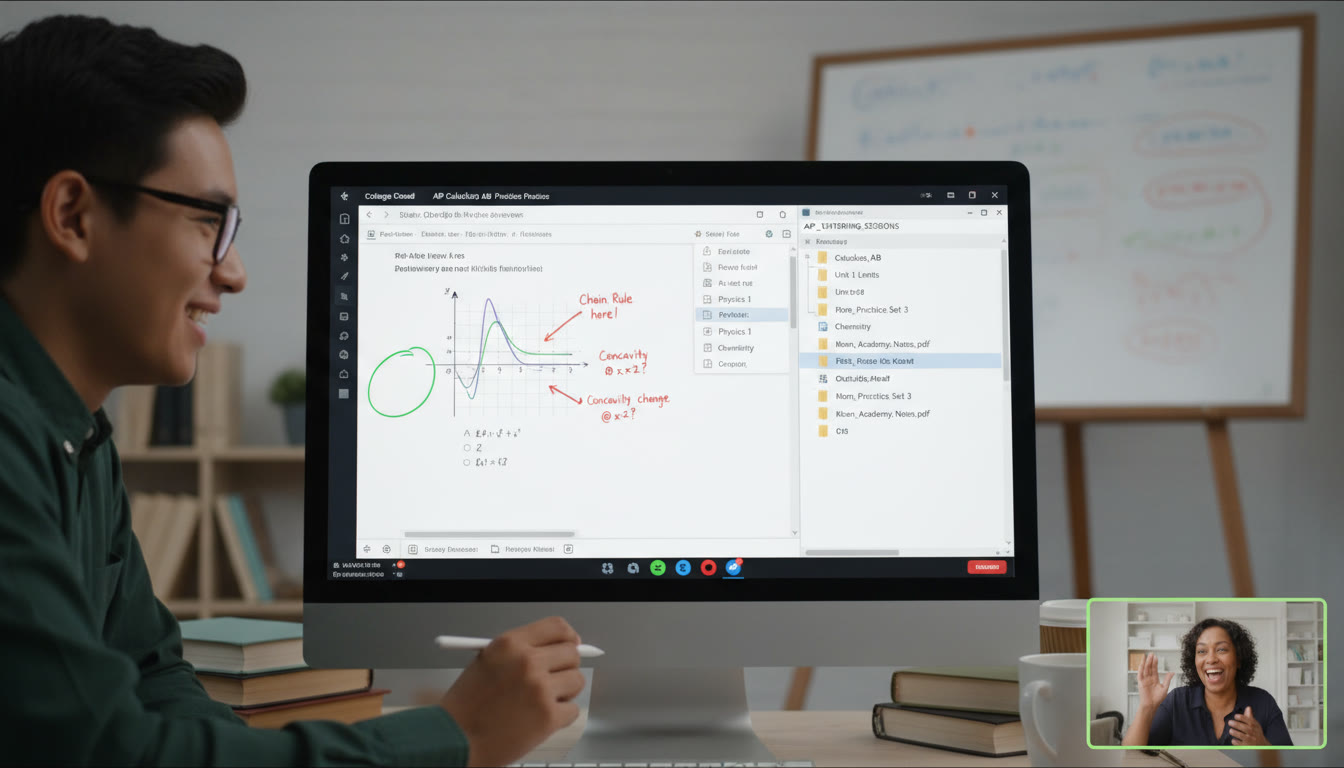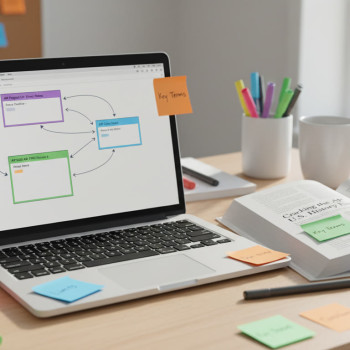Why a Digital Folder Architecture Matters for AP and Board Exams
Imagine opening your laptop the week before an AP exam and finding everything you need in seconds: unit summaries, scored practice, lab reports, formula sheets, and tailored feedback from a tutor. No frantic searching. No lost files. For students balancing AP courses and various board-level expectations, a well-built digital folder architecture is the difference between confident preparation and last-minute chaos.
This guide is written for students and parents who want a practical, human approach to digital organization. We’ll walk through a folder system that works for advanced placement (AP) classes and board exams alike, show you examples, present tables you can copy, and offer workflow tips that help retain knowledge and reduce stress. And yes — we’ll occasionally highlight how Sparkl’s personalized tutoring fits naturally into this plan to accelerate progress.

Principles of a Resilient Folder Architecture
1. Simplicity over cleverness
Folders that are too deep or use obscure naming conventions break under pressure. Aim for a structure you can navigate blindfolded. If parents and peers can understand it in one minute, it’s simple enough.
2. Consistency is your secret weapon
Use the same naming and versioning scheme across all courses. When you write a new note or upload a practice exam, you should know exactly where it goes and how to name it. This eliminates decision fatigue.
3. Redundancy without clutter
Backups are non-negotiable — local and cloud. But avoid duplicating active files in too many places. Set up automatic syncing for working folders and a weekly snapshot folder for long-term archives.
4. Make retrieval faster than recreation
Design your folders so finding a resource takes less time than redoing it. If it’s faster to recreate a study guide than to find it, your system isn’t working.
An AP-Friendly Folder Template (Course-Level)
Below is a course-level folder template you can copy and adapt. Use this for each AP or board subject (e.g., AP Biology, AP U.S. History, Chemistry, Calculus AB, etc.). Place a high-priority or frequently used course in the root of your study drive for faster access.
| Folder | Purpose | Examples of Contents |
|---|---|---|
| 00_Quick Access | Daily essentials and exam checklist | Today’s plan.docx, FormulaSheet.pdf, Exam Day Checklist.pdf |
| 01_Syllabus & Calendar | Master schedule and unit map | Syllabus.pdf, Unit Calendar.xlsx, AP Topic Checklist.xlsx |
| 02_Lectures & Notes | Organized by unit and date | Unit01_LectureNotes.pdf, Unit02_Slides.pptx |
| 03_Practice Exams | Full-length and timed practice | AP_Practice_2024_Exam1.pdf, Scored_Exam1_Solutions.docx |
| 04_Problem Sets & Labs | Homework, lab reports, data sets | Lab03_Report.pdf, ProblemSet05_Solutions.docx |
| 05_Revision Materials | Condensed notes, flashcards, cheat-sheets | Unit01_Summary.docx, Flashcards_Unit02.qsf |
| 06_Tutor Feedback | 1-on-1 notes and tailored plans | Sparkl_Session_2024-09-15.pdf, TutorPlan_Week3.docx |
| 07_Assessments | Quizzes, graded assignments, rubrics | Quiz02_Grade.pdf, Midterm_Exam_Results.xlsx |
| 08_Archived Version History | Snapshots of important files | Version_2024-04-01.zip, OldNotes_2023 |
Naming Conventions That Actually Work
Good names are short, readable, and sortable. Use leading numbers to control order and ISO dates (YYYY-MM-DD) for chronological clarity.
- Prefer: 2025-03-15_Lab03_Report.pdf
- Avoid: LabFinalNewVersionReallyUpdatedFinal(2).pdf
Suggested template: <YYYY-MM-DD>_<Type>_<Unit/Topic>_<BriefDesc>.ext
Examples:
- 2025-04-02_Practice_Unit4_FRQ_SetA.pdf
- 2025-02-20_Summary_Unit1_Evolution.docx
Folder Workflow: Daily, Weekly, and Monthly Routines
Daily (10–30 minutes)
- Save today’s notes to 02_Lectures & Notes immediately after class.
- Update 00_Quick Access with a one-line plan for tomorrow.
- Sync actively used folder with cloud storage so devices stay current.
Weekly (30–60 minutes)
- Move completed assignments to 07_Assessments and add tutor feedback to 06_Tutor Feedback.
- Create a weekly revision pack in 05_Revision Materials that summarizes what you studied.
- Run a quick search for duplicates and delete or archive as needed.
Monthly (45–90 minutes)
- Archive older files to 08_Archived Version History (create a zip labeled by month).
- Refine practice exam selection in 03_Practice Exams — keep the most recent two scored copies and archive the rest.
- Review your syllabus map in 01_Syllabus & Calendar and adjust priorities.
How Versioning Prevents Disaster
Accidental overwriting is common when working on long-form documents like research reports or lab write-ups. Use version tags and keep an ‘active’ working copy in the root of your course folder. Once a draft is complete, move it to the appropriate subfolder and tag it with a version number.
- Filename_v1.docx (first draft)
- Filename_v2_tutor-edits.docx (after tutor comments)
- Filename_final_2025-04-10.pdf (final submission)
Search and Tagging: Make Your Files Findable
Search is only as good as the metadata you give your files. Use built-in document properties or a one-line summary at the top of notes that includes keywords and dates. If you use a cloud system that supports tags, create a simple tag taxonomy like:
- Topic: Evolution, Thermodynamics, U.S. History
- Type: Lecture, Practice, Formula Sheet
- Priority: High, Medium, Low
Examples and Real-World Context
Scenario: It’s May and your AP exam is in two weeks. You open 00_Quick Access and find a clear, two-week plan. Each practice test and scored answer is in 03_Practice Exams, with tutor feedback in 06_Tutor Feedback indicating the three high-yield areas you need to improve. You and your Sparkl tutor run a 1-on-1 session reviewing one FRQ per day and saving annotated versions back to the folder structure. Result: targeted improvement, saved time, and less stress.
Integrating Tutoring Notes and AI Insights
Personalized tutoring works best when it’s connected to your materials. If your tutor — for example, from Sparkl — can access (or you can share) a tidy folder with practice tests and past feedback, every session becomes more efficient.
- Upload session notes to 06_Tutor Feedback with a date stamp.
- Create a TutorActionItems.docx in the same folder summarizing the 3 next steps after each session.
- Use AI-driven summaries to generate concise revision packs and store them in 05_Revision Materials.
When Sparkl’s tutors tailor study plans from your actual files, instead of guessing, they can identify precise misconceptions and suggest targeted practice — making 1-on-1 time far more effective.
Security and Privacy: Keep Your Data Safe
Privacy matters, especially if you store graded work or personal notes. Follow these simple rules:
- Enable two-factor authentication on your cloud accounts.
- Use a password manager to create unique passwords for school and personal accounts.
- Avoid storing sensitive personal info (SSNs, family financial details) in these folders.
Cross-Platform Tips: Phones, Laptops, and Tablets
Use a ‘working’ folder that syncs across devices for active study, and a separate ‘archive’ folder that only syncs when on Wi-Fi to save bandwidth. Many cloud services allow selective sync — use it to keep your laptop uncluttered but your cloud complete.
A Sample Two-Week Revision Plan Using the Folder System
Below is a compact plan you can copy into 00_Quick Access and adapt to any AP subject.
| Day | Focus | Folder Actions | Outcome |
|---|---|---|---|
| Day 1 | Full Practice Exam (timed) | Save to 03_Practice Exams, run scorer, upload scores | Baseline score and time profile |
| Day 2 | Review FRQs and high-error topics | Move key FRQs to 05_Revision Materials | Targeted topic list |
| Day 3 | Tutor session: focused review | Save session notes to 06_Tutor Feedback, create TutorActionItems.docx | Personalized plan |
| Day 4–6 | Timed practice sets and active recall | Store corrected sets in 03_Practice Exams and 05_Revision Materials | Skill reinforcement |
| Day 7 | Consolidation and rest | Archive older practice to 08_Archived Version History | Reduced cognitive fatigue |
| Day 8–13 | Micro-practice and spaced review | Create one-page summaries in 05_Revision Materials | Long-term retention |
| Day 14 | Light review and logistics | Check 00_Quick Access checklist for exam day | Calm and prepared |
Tools and Shortcuts That Speed Up the System
You don’t need expensive apps to make this work—just consistent habits. Still, here are practical features you should learn in whatever cloud or note app you use:
- Batch rename files (for clean versioning)
- Shared folders for collaborative projects or tutor review
- Comments and suggestions mode for teacher and tutor feedback
- Document outline features to jump between topics quickly
Automation Ideas
Set up simple automations: save email attachments to a designated ‘Inbox’ folder that you process weekly, or have completed assignments automatically moved to 07_Assessments with a filter. These little automations keep the system tidy without daily effort.
Parents: How to Support Without Taking Over
Parents can help by encouraging structure and checking that backups exist — but avoid reorganizing your child’s folders for them. Offer these supports instead:
- Help set up cloud accounts and backup routines.
- Encourage weekly review sessions and celebrate consistent habits.
- If tutoring is part of the plan, ensure sessions are scheduled and that session notes are saved for later review.
When to Ask for Help (and How Sparkl Can Fit In)
If your scores plateau or your study time feels inefficient, a targeted tutor can help diagnose the issue quickly. Sparkl offers 1-on-1 guidance with expert tutors who can work directly from your organized folders — reviewing scored practice, annotating mistakes, and designing tailored study plans. When tutoring sessions reference actual files from your own folder architecture, the advice becomes actionable and immediate rather than theoretical.
Common Mistakes and How to Fix Them
- Procrastinating on organizing: Fix it by spending 20 minutes on a weekend to set up the basic template. Momentum matters.
- Over-nesting folders: If you need more than three clicks to reach a file, flatten the structure.
- Ignoring tutor feedback: Always save and act on tutor notes. If a suggestion isn’t clear, ask for a short follow-up and store that note in 06_Tutor Feedback.
Sample Folder Checklist to Copy
Use this checklist to confirm your course folder contains the essentials.
- 00_Quick Access — Two-week plan and formulas
- 01_Syllabus & Calendar — Unit map
- 02_Lectures & Notes — Organized by date/unit
- 03_Practice Exams — Timed and scored
- 04_Problem Sets & Labs — Graded and raw data
- 05_Revision Materials — One-page summaries
- 06_Tutor Feedback — Action items and dated notes
- 07_Assessments — Grades and rubrics
- 08_Archived Version History — Monthly snapshots
Final Checklist for Exam Week
Two days before the AP exam, run this quick audit:
- Open 00_Quick Access — confirm exam-day checklist is current.
- Confirm last three practice exams are in 03_Practice Exams with scores.
- Ensure tutor has uploaded final feedback to 06_Tutor Feedback.
- Make a copy of the essential revision sheet and save it to your phone or tablet for quick review.
- Backup critical files to an external drive or alternate cloud account.
Wrapping Up: Systems That Reduce Stress and Boost Scores
Digital folder architecture is more than just tidiness — it’s a study strategy. When notes, practice, and feedback are connected, learning accelerates. By applying the simple templates and routines in this guide, you’ll spend less time looking for files and more time improving the skills that matter for AP and board success.
And when targeted help makes sense, personalized tutors — like those at Sparkl — can plug into your folders, review your work, and craft step-by-step plans tied directly to your materials. That alignment is powerful: it turns organized effort into measurable progress.

Ready-to-Use Starter Template (Copy-Paste Friendly)
Copy these folder names exactly into your cloud drive to get started fast:
- 00_Quick Access
- 01_Syllabus & Calendar
- 02_Lectures & Notes
- 03_Practice Exams
- 04_Problem Sets & Labs
- 05_Revision Materials
- 06_Tutor Feedback
- 07_Assessments
- 08_Archived Version History
A Final Note to Students and Parents
Start small. Don’t try to perfect everything in one night. Build the folder skeleton today, move last week’s notes into it, and try the two-week revision plan. The structure will repay you in calm, clear study time and better exam performance. If you want help translating your materials into a personalized plan, consider a brief session with a tutor who can work from your files and help you prioritize efficiently.
Good luck — and remember: the best system is the one you use consistently. Organize once, study smarter forever.



















No Comments
Leave a comment Cancel